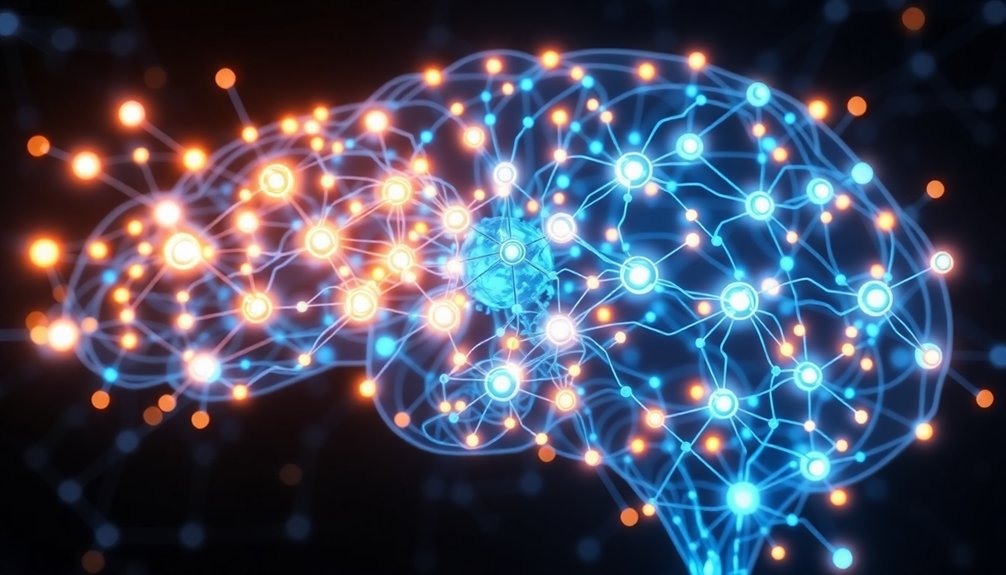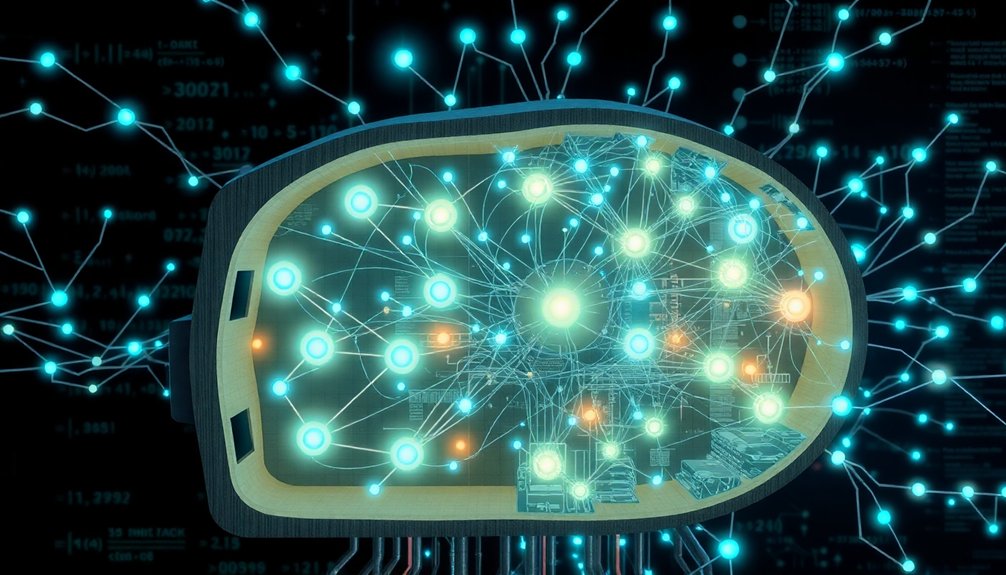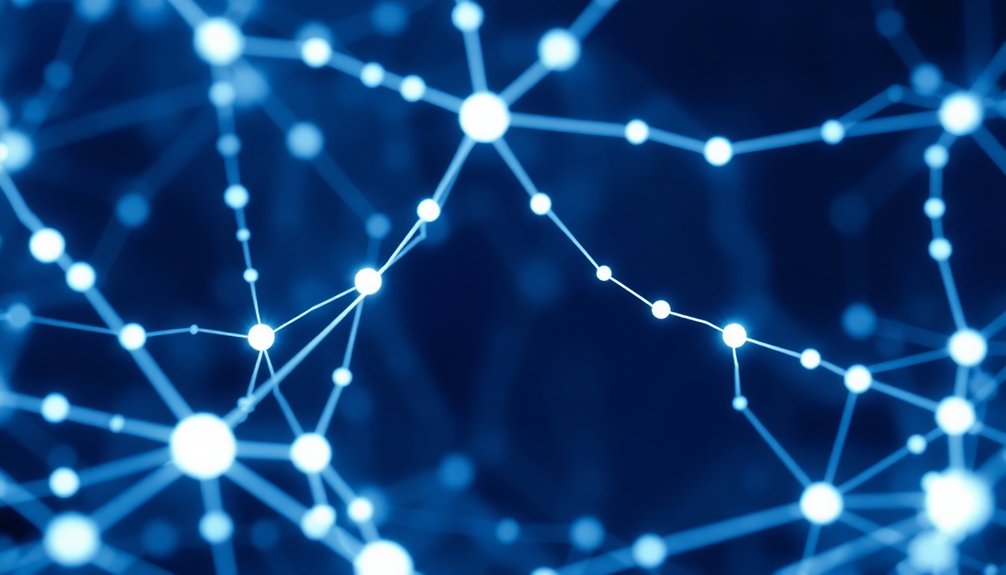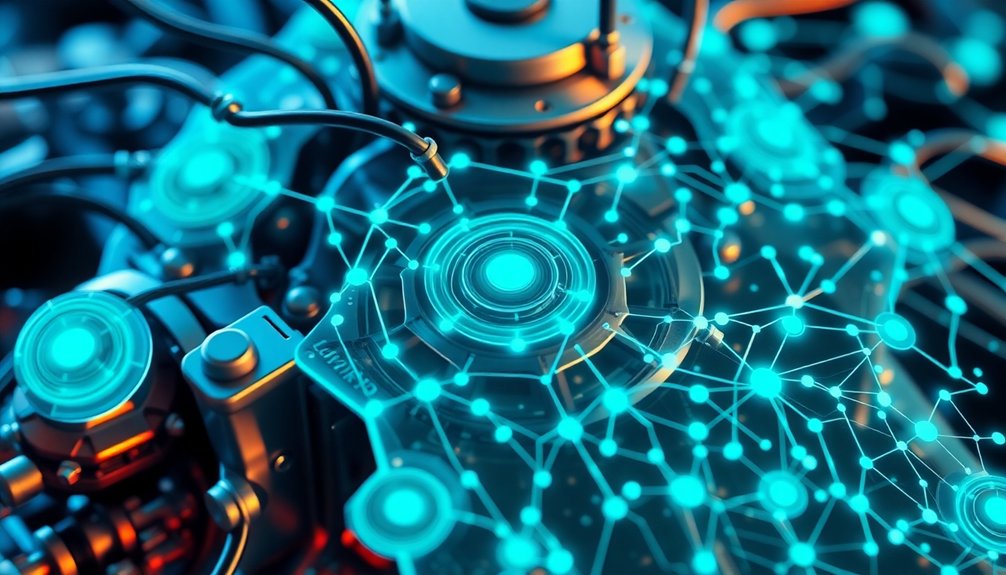Robots aren’t just programmed machines anymore—they’re thinking, adapting systems that process sensory data lightning-fast. Using neural networks, they analyze visual, auditory, and tactile inputs in milliseconds, making split-second decisions like a superhuman chess player. Machine learning algorithms help them learn from each interaction, continuously refining their strategies. They’re not just reacting; they’re predicting and problem-solving. Curious how these digital brains actually work? Stick around, and you’ll see the future unfold.
The Cognitive Architecture of Intelligent Machines

When you peek under the hood of modern robotics, the cognitive architecture of intelligent machines looks less like a cold, calculating computer and more like a nimble brain constantly learning and adapting.
These AI systems aren’t just programmed—they’re designed to think on their feet, processing sensory inputs like neural networks that mimic human cognition. Your robot buddy doesn’t just follow instructions; it makes autonomous decisions by analyzing massive data streams in milliseconds.
Imagine a machine that learns from its mistakes, refines its decision-making strategies, and grows smarter with every interaction. Neuromorphic computing is revolutionizing machine thinking by enabling robots to process information more efficiently and adaptively, much like the human brain.
Machines evolving through experience, constantly learning and transforming intelligence with each dynamic interaction.
That’s the magic of cognitive architecture. It’s not about replacing humans, but creating intelligent systems that can navigate complex, unpredictable environments with remarkable flexibility and precision.
Sensory Input Processing in Real-Time Environments
Imagine an AI brain processing visual, auditory, and tactile information faster than you can blink. These machines use neural networks to analyze complex environments, whether they’re maneuvering autonomous vehicles or assembling parts on a factory floor.
Machine learning algorithms let robots adapt in real-time, transforming sensory input processing from a rigid script to a dynamic dance of computational intelligence. They’re constantly learning, predicting, and reacting—no human hand-holding required.
Want proof? Watch how quickly a robot can detect an obstacle and reroute its path, making decisions that would take humans precious milliseconds longer. It’s not science fiction; it’s happening right now.
Tactile sensors enable robots to process environmental data with unprecedented precision, converting complex touch signals into actionable insights through advanced neural networks.
Machine Learning Algorithms Driving Robotic Decision-Making

As if robots weren’t already mind-blowing enough, machine learning algorithms are turning these mechanical marvels into decision-making powerhouses that would make most humans look like indecisive toddlers.
These algorithms are transforming robotics by enabling real-time decisions through:
- Adaptive learning that allows robots to modify behaviors instantly
- Neural network processing for complex environmental analysis
- Reward-based optimization techniques that refine performance
Machine learning algorithms let robots adapt to new challenges faster than you’d imagine. By analyzing massive data streams, they’re not just following pre-programmed instructions—they’re actively learning, predicting, and responding with remarkable precision. Deep reinforcement learning enables robots to evolve through experience, transforming potential into intelligent behavior.
Machine learning propels robots beyond coding—they’re now intuitive learners transforming challenges into opportunities.
Want proof? Deep learning techniques now help robots recognize speech, navigate unpredictable terrain, and make split-second choices that would stump most humans.
The future isn’t just automated—it’s intelligently responsive.
Neural Networks: The Brain Behind Robotic Intelligence
If robots are the body, neural networks are definitely the brain—a complex, lightning-fast system that turns mechanical parts into thinking machines.
These digital neurons mimic human brain connections, enabling robots to learn and make real-time decisions with stunning precision. Deep learning allows them to recognize patterns faster than you’d imagine, processing complex data through multiple interconnected layers.
Want to know how? Each neural network neuron takes input, processes it, and passes results to the next layer—like a high-speed relay race of information. By continuously adjusting internal weights through backpropagation, these networks get smarter with every interaction.
They’re not just following programmed instructions; they’re dynamically adapting, analyzing, and responding to unpredictable environments. Imagine a robot that learns and improves autonomously—that’s neural networks in action. Deep reinforcement learning enables robots to evolve through experience, transforming them from rigid machines to adaptive intelligent systems.
Pattern Recognition and Predictive Analytics

You’ve probably wondered how robots seem to “think” on their feet, right?
Machine learning algorithms are the secret sauce that lets robots recognize patterns faster than you can blink, processing real-time data to map out predictive decisions that can anticipate everything from potential manufacturing hiccups to the exact moment a robot needs maintenance.
It’s like giving machines a crystal ball powered by math and relentless computational curiosity. Depth estimation techniques enable robots to continuously update their mental maps, allowing them to make split-second decisions and predict obstacles with remarkable precision.
Machine Learning Algorithms
When robots start learning like curious kids on a playground, machine learning algorithms become their intellectual playgrounds. These brainy bits of code transform robots from clunky machines into adaptive problem-solvers. Sensor fusion techniques enable robots to integrate multiple data inputs simultaneously, enhancing their decision-making capabilities.
They’re not just following pre-programmed instructions; they’re making real-time decisions based on:
- Visual input processing
- Sensory data interpretation
- Predictive pattern recognition
Machine learning algorithms enable robots to recognize complex patterns faster than humans, fundamentally giving them a supercharged brain for decision-making. By analyzing massive datasets in milliseconds, these algorithms help robots navigate unpredictable environments, avoid obstacles, and learn from their experiences.
Think of it like a sophisticated game of trial and error, where each interaction makes the robot smarter and more responsive. Isn’t it wild how code can now teach machines to think on their feet—or wheels?
Real-Time Data Processing
Imagine robots as digital detectives, constantly scanning their environment and piecing together complex puzzles in real-time.
AI enables these mechanical marvels to process data faster than you can blink, turning raw information into lightning-quick decisions. Through real-time data processing, robots transform from clunky machines into intuitive problem-solvers. They’re not just following pre-programmed scripts; they’re learning and adapting on the fly.
Machine learning algorithms enable robots to enhance their sensory perception, processing inputs from cameras, microphones, and tactile sensors to make increasingly sophisticated decisions.
Predictive analytics lets these smart machines forecast potential scenarios, like chess players thinking ten moves ahead.
Want to know how they do it? Machine learning algorithms crunch historical data, spotting patterns humans might miss.
Predictive Decision Mapping
Because pattern recognition isn’t just a fancy tech buzzword, it’s the secret sauce that turns robots from mindless machines into predictive powerhouses. Your AI’s predictive decision mapping isn’t playing checkers; it’s playing 4D chess with data. Neural network algorithms enable robots to learn complex movement patterns by continuously analyzing sensor inputs and predicting environmental changes.
Consider how predictive analytics transforms robotic intelligence:
- Real-time decisions become lightning-fast predictions
- Pattern recognition decodes complex environmental signals
- Maintenance strategies shift from reactive to proactively brilliant
Imagine an autonomous vehicle that doesn’t just react, but anticipates. It reads road conditions like a chess grandmaster reads an opponent’s strategy.
Adaptive Learning and Continuous Improvement

As artificial intelligence continues to evolve, robots aren’t just following pre-programmed scripts anymore—they’re learning and adapting in real-time, almost like digital versions of quick-thinking problem solvers. Adaptive learning transforms robots from rigid machines into flexible performers that continuously improve through machine learning algorithms. Virtual simulation technologies like Isaac Gym are enabling robots to practice complex movements and decision-making strategies at unprecedented speeds and scales.
| Skill | Improvement Method |
|---|---|
| Navigation | Pattern Recognition |
| Decision Making | Experience Analysis |
| Task Complexity | Neural Network Optimization |
| Environmental Adaptation | Sensory Feedback Processing |
Real-time decision-making isn’t just cool tech—it’s revolutionary. These AI-powered systems can process massive data streams, recognize subtle patterns, and adjust strategies on the fly. Imagine a robot that learns from its mistakes faster than you’d correct a typo. They’re becoming more autonomous, more intelligent, and frankly, a bit more human-like with each iteration. Who knew machines could be such quick studies?
Complex Problem-Solving in Dynamic Scenarios
You’ve heard robots are smart, but wait until you see how they actually solve problems in real time.
By blending adaptive learning mechanisms with split-second sensory processing, these machines can now analyze complex scenarios faster than you can blink, predicting potential outcomes and adjusting their strategies on the fly.
Imagine a robot that doesn’t just react, but strategically navigates unpredictable environments — that’s not sci-fi, that’s the cutting edge of AI problem-solving happening right now. Through digital twin simulations, robots can train in hyper-realistic virtual environments, mastering intricate tasks and decision-making strategies before real-world deployment.
Adaptive Learning Mechanisms
When robots start thinking like nimble problem-solvers instead of rigid machines, that’s when things get really interesting. Adaptive learning mechanisms are transforming AI from predictable automatons into dynamic decision-makers that can:
- Process real-time environmental data instantaneously
- Learn from past experiences and adjust strategies
- Make autonomous decisions without constant human guidance
Machine learning (ML) is the secret sauce enabling robots to optimize their operational efficiency. Instead of following pre-programmed scripts, these smart systems analyze patterns, predict challenges, and dynamically respond to unpredictable scenarios.
Imagine a robot that doesn’t just follow orders, but actually understands them—learning, adapting, and improving with each interaction. It’s like giving machines a brain that’s part computer, part intuition, constantly evolving to tackle complex problems more intelligently than ever before.
Who wouldn’t want a teammate that gets smarter every single day?
Real-Time Sensory Processing
From predicting patterns to processing reality, robots are leveling up their sensory game in ways that’ll make your sci-fi fantasies look like child’s play.
Real-time sensory processing isn’t just cool tech—it’s how machines turn raw data into lightning-fast decisions. Imagine an AI that can detect a potential obstacle milliseconds before you even blink, then instantly chart a new course.
Machine learning allows these digital brains to adapt and improve with each encounter, building a mental map that gets sharper and smarter.
Predictive analytics transform robots from reactive machines into proactive problem-solvers, anticipating changes before they happen.
Autonomous decision-making means these mechanical marvels can navigate complex scenarios without breaking a sweat—or a circuit.
Who knew robots could be this intuitive?
Predictive Decision Strategies
Buckle up for the wild world of robot problem-solving, where artificial intelligence isn’t just crunching numbers—it’s predicting the future like a digital fortune teller on steroids.
AI systems are revolutionizing how robots tackle complex challenges through predictive decision strategies that’d make a chess grandmaster look like an amateur.
Here’s how these brainy machines work their magic:
- Machine learning models analyze mountains of historical data
- Real-time data processing enables split-second adaptations
- Predictive analytics transform raw information into actionable insights
Imagine a robot that doesn’t just react but anticipates—like a digital ninja sensing danger before it strikes.
These AI-powered problem-solvers can optimize everything from supply chain logistics to emergency response, turning potential chaos into calculated precision.
They’re not just thinking; they’re strategically predicting your next move.
Sensor Fusion and Multi-Modal Data Integration
Because robots aren’t just fancy calculators anymore, sensor fusion has become the secret sauce that transforms them from rigid machines into adaptable problem-solvers.
Imagine a robot that doesn’t just see, but truly perceives—combining visual, auditory, and tactile data to understand its environment like a hyper-intelligent Swiss Army knife. Multi-modal data integration lets these mechanical brains filter out noise and make lightning-fast decisions.
Want proof? Think about autonomous vehicles maneuvering chaotic streets or surgical robots performing delicate procedures. They’re not guessing; they’re processing multiple sensor inputs simultaneously, creating a real-time, thorough understanding that would make human reflexes look like slow motion.
Overcoming Challenges in Robotic Perception and Response

Sensor fusion might seem like robotic wizardry, but the real magic happens when those mechanical brains hit roadblocks. AI in Robotics faces serious perception challenges that test the limits of machine intelligence.
- Processing massive sensory data without breaking a digital sweat
- Interpreting complex environmental signals in milliseconds
- Adapting machine learning algorithms on the fly
Robotic perception isn’t just about seeing—it’s about understanding. When your mechanical buddy encounters an unexpected scenario, its decision-making kicks into high gear.
Machine Learning (ML) enables these systems to learn from each interaction, refining their responses like a seasoned chess player anticipating moves.
Think of it as training a hyper-intelligent puppy that never gets tired and can calculate probabilities faster than you can blink. The future of robots isn’t about replacing humans—it’s about collaborating in ways we’re just beginning to imagine.
People Also Ask About Robots
How Does AI Make Its Decisions?
You’ll process massive datasets through neural networks, recognize patterns, and make split-second predictions by analyzing complex information. Your algorithms learn from past experiences, adapting quickly to interpret new inputs and generate intelligent, context-driven decisions.
How Does a Robot Make Decisions?
You’ll process sensory data instantly, analyze patterns, and predict outcomes using AI algorithms. Your machine learning capabilities help you adapt, make autonomous choices, and respond efficiently to dynamic environments in real-time.
How Is AI Used in Robotics?
You’re the beating heart of innovation, where AI breathes life into robots. It transforms machines through machine learning, computer vision, and adaptive algorithms, enabling them to process data, learn from experiences, and make intelligent, autonomous decisions in real-time.
How Does AI Decide What Is True?
You’ll find AI determines truth by analyzing massive datasets, recognizing patterns, and calculating probabilities through machine learning algorithms that continuously refine understanding based on statistical correlations and emerging evidence.
Why This Matters in Robotics
You’ve seen how robots aren’t just metal and circuits—they’re thinking machines learning faster than you can blink. Imagine a self-driving car dodging obstacles in milliseconds, using neural networks that process information like a hyper-intelligent chess player. AI isn’t just mimicking human decision-making; it’s reimagining it. The future isn’t about robots replacing humans, but collaborating in ways we’re just beginning to understand. Buckle up—it’s going to be a wild ride.
